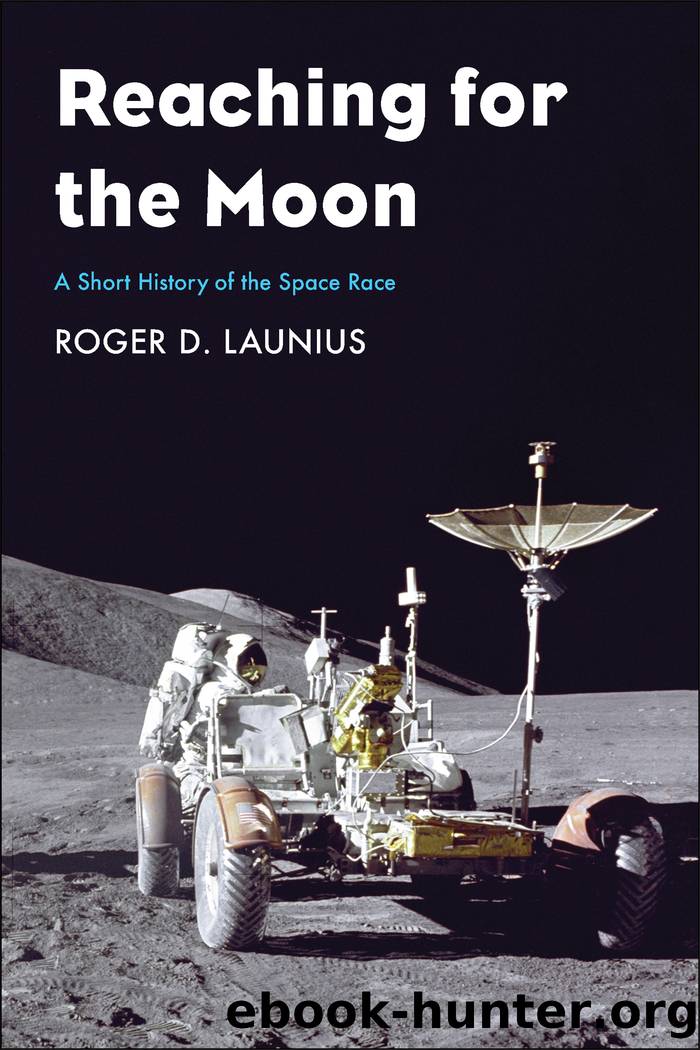Reaching for the Moon by Roger D Launius;

Author:Roger D Launius;
Language: eng
Format: epub
Publisher: Yale University Press
Published: 2019-01-15T00:00:00+00:00
A Spacecraft Built for Two (or Three): Voskhod and Soyuz
After the success of the early Vostok flights in 1961â1963, Sergei Korolevâs design bureau developed the Voskhod spacecraft as a larger, more capable capsule for either two or three cosmonauts. Scaled up from Vostok, the spherical capsule contained the cosmonauts and instruments, and a conical equipment module held engine and propellant. Because of its weight, Korolev used an enhanced R-7 launch vehicle, which later became the basis of the Soyuz booster. Voskhod would later be superseded in 1967 by Soyuz, which with updates and modifications is still used by Russia.
The Soviet Union intended the Voskhod program to explore how the human body reacted to space, but its first two flights satisfied Nikita Khrushchevâs thirst for space spectaculars. Voskhod 1, October 12â13, 1964, flew three cosmonauts, and Voskhod 2, March 18â19, 1965, achieved the first extravehicular activity (EVA), or âspacewalk.â After Khrushchev was deposed in October 1964, new USSR leadership shifted away from spaceflights aimed at gaining world prestige, allowed Korolev to cancel the Voskhod program, and put more emphasis on a lunar-landing program.
Voskhod proved, at best, an unimpressive spacecraft, and Korolev chomped at the bit to replace it with something more robust. His lieutenants in OKB-1 worked on a more capable spacecraft named Object 7K or Soyuz (Russian for âunionâ), initiated in 1962, not long after the U.S. decision to land on the Moon by the end of the decade. Korolev pressed his engineers to build a spacecraft that could send two cosmonauts on a circumlunar flight (Box 3). This proved impractical with the Soyuz capsule, and in 1965 Korolev backtracked to a more modest goal, emphasizing Earth orbital missions of a type and complexity not yet demonstrated by the Americans.
By the fall of 1966 Soyuz was ready for test flights, although Korolev, who had died that January, was not there to see it. The spacecraft that emerged consisted of three modules that weighed about 7.25 tons. The first module contained instruments and service components, as well as electrical and propulsion systems. A habitation module provided accommodation for the crew during its mission, and a small aerodynamic reentry module returned the crew to Earth.
Soyuz made its first flight with a cosmonaut on April 23, 1967; Vladimir Komarovâs Soyuz 1 was intended to rendezvous with a three-cosmonaut Soyuz 2, but the mission ran into all manner of problemsânot only did Soyuz 1âs solar panels fail to extend, causing intermittent electrical outages, but attitude and stability systems also proved disastrously inadequateâand Komarov had to return to Earth. During reentry Soyuz 1âs primary and reserve parachutes also failed, causing a crash that killed Komarov on impact, the first Soviet fatality directly related to space exploration and the first inflight death during spaceflight. As his capsule plunged through the atmosphere, Komarov could be heard through the radio say, âHeat is rising in the capsule.â He also pronounced himself âkilledâ as he lunged earthward.
BOX 3: VOSKHOD SPECIFICATIONS
Spacecraft type
Download
This site does not store any files on its server. We only index and link to content provided by other sites. Please contact the content providers to delete copyright contents if any and email us, we'll remove relevant links or contents immediately.
De Catalaanse brief by Robert Goddard(270)
A Piece of Cake by Sarah Swatridge(216)
Nonlinear Dynamics and Chaos with Student Solutions Manual by Steven H. Strogatz(200)
The Ruin of J. Robert Oppenheimer by Priscilla J. McMillan(176)
Churchill's Spearhead by John Greenacre(167)
Popular Culture and Political Identity in the Arab Gulf States by Alanoud Alsharekh Robert Springborg(152)
Flowering of the Cumberland by Harriette Simpson Arnow(151)
thing bounces back europe by Unknown(148)
Allied Bombing Raids by Philip Kaplan(140)
A Japanese View of Nature by Kinji Imanishi Pamela J. Asquith(139)
Guild and State by Antony Black(130)
Comet Madness by Richard J. Goodrich(130)
A History of Science in Society by Ede Andrew;Cormack Lesley B.;(117)
RAF at the Crossroads by Greg Baughen(116)
A History of Greek and Roman Philosophy by John Hackney(116)
The Seventies Now: Culture As Surveillance by Stephen Paul Miller(115)
History Without A Subject by David Ashley(112)
Shocking Bodies by Iwan Rhys Morus(109)
Air Battle for Burma by Evans Bryn;(109)
